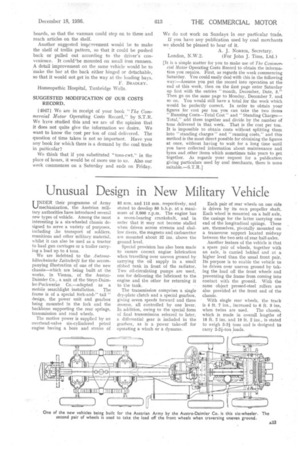Unusual Design in New Military Vehicle
Page 51

If you've noticed an error in this article please click here to report it so we can fix it.
UNDER their programme of Army mechanization, the Austrian military authorities have introduced several new types of vehicle. Among the most interesting is a six-wheeled chassis designed to serve a variety of purposes, including :he transport of soldiers, munitions and other military material, whilst it can also be used as a tractor to haul gun carriages or a trailer carrying a load up to 4 tons.
We are indebted to the Autornobiltechnische Zeitschrift for the accompanying illustration of one of the new chassis—which are being built at the works, in Vienna, of the AustroDaimler Co., a unit of the Steyr-Daimler-Puckwerke Co.—adapted as a
mobile searchlight installation. The frame is of a special fork-and-" tail " design, the power unit and gearbox being mounted in the fork and the backbone supporting the rear springs, transmission and road wheels.
The motive power is supplied by an overhead-valve six-cylindered petrol engine having a bore and stroke of 85 mm. and 115 ram. respectively, and stated to develop 80 b.h.p. at a maximum of 3,000 r.p.m. The engine has a seven-bearing crankshaft, and in order that it may not become stalled when driven across streams and shallow rivers, the magneto and carburetter are mounted about 32 ins, above the ground level, Special provision has also been made to ensure correct engine lubrication when travelling over uneven ground by carrying the oil supply in a small ribbed tank in front of the radiator. Two oil-circulating pumps are used, one for delivering the lubricant to the engine and the other for returning it to the tank.
The transmission comprises a single dry-plate clutch and a special gearbox, giving seven speeds forward and three reverse, all controlled by one lever. In addition, owing to the special form of final transmission referred to later, a differential gear is included in the gearbox, as is a power take-off for operating a winch or a dynamo. Each pair of rear wheels on one side is driven by its own propeller shaft. Each wheel is mounted on a half axle, the casings for the latter carrying one end of the longitudinal springs. These are, themselves, pivotally mounted on a transverse support located midway between the two sets of rear half-axles.
Another feature of the vehicle is that a spare pair of wheels, together with an axle, is carried behind and at a higher level than the usual front pair. Its purpose is to enable the vehicle to be driven over uneven ground by taking the load off the front wheels and preventing the frame from coming into contact with the ° ."ronn-d. With the same object pressed-steel rollers are also provided at the front end of the chassis.
With single rear wheels, the track is 4 ft. 7 ins., increased to 6 ft. 3 ins.
when twins are used. The chassis, which is made in overall lengths of 18 ft. 2 ins. and 19 ft. 2 ins., is stated to weigh 3-31 tons and is designed to carry 2-21-ton loads.




















































































